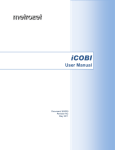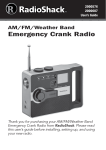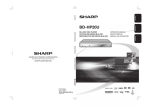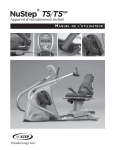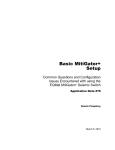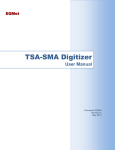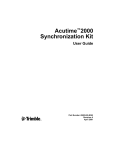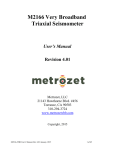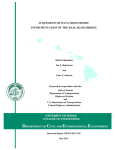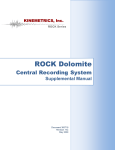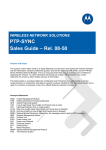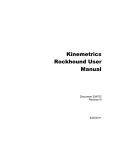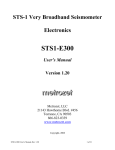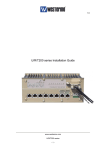Download User Manual
Transcript
EQMet iDAS User Manual Document 305201 Revision NC April 2012 Warranties,Disclaimers&Trademarks Copyright © 2008‐2012 EQMet, LLC. The trademarks used throughout this manual, registered or not, are: EQMet, Metrozet, Kinemetrics, iDAS, TSA‐100S‐D24, Rockhound and Linux. This publication is provided "as is" without warranty of any kind, either expressed or implied, including, but not limited to, the implied warranties of merchantability, fitness for a particular purpose, or non‐ infringement. Metrozet, LLC, Kinemetrics Inc. and its affiliates assume no responsibility for errors or omissions in this publication or other documents which are referenced by or linked to this publication. References to corporations, their services and products, are provided "as is" without warranty of any kind, either expressed or implied. In no event shall Metrozet, LLC or Kinemetrics Inc. be liable for any special, incidental, indirect or consequential damages of any kind, or any damages whatsoever, including, without limitation, those resulting from loss of use, data or profits, whether or not advised of the possibility of damage, and on any theory of liability, arising out of or in connection with the use or performance of this information. This publication could include technical or other inaccuracies or typographical errors. Changes are periodically added to the information herein; these changes will be incorporated in new editions of the publication. All rights reserved. No part of this publication may be copied, photocopied, reproduced, transmitted, transcribed, or reduced to any electronic medium or machine‐readable form without prior written consent. Notice We reserve the right to make improvements in the software described in this documentation at any time and without notice. The information contained here is subject to change without notice. The software described in this document is provided as a licensed item, in conjunction with this equipment. It may not be copied or distributed for use on other than the equipment it was licensed for. Disclaimer Metrozet LLC and Kinemetrics Inc. shall have no liability or responsibility to you or any other person or entity with respect to any liability, loss or damage caused or alleged to be caused directly or indirectly by this documentation or the software described in it. This includes but is not limited to any interruption of service, loss of business or anticipatory profits or consequential damages resulting from the use or operation of such software or computer programs. Warranty We warrant each new EQMet product for a period of one year from date of shipment. Defects in material or workmanship found within that period will be replaced or repaired (at our option) without charge for materials or labor. Before returning any product to EQMet please request an RMA number through EQMet Technical Support and make reference to this number in any following correspondence. Once the warranty return of a product is authorized we will pay the round trip freight charges to the factory for repair under warranty. If subsequent evaluation establishes that necessary repairs are due to misuse, then the customer must assume all charges. Insurance for all shipments, either first sale or repair, is the responsibility of the customer. Other Equipment Manufacturers (OEM) included in systems (e.g. peripherals, options) are warranted for 90 days from date of shipment. OEM components may be warranted by the original equipment manufacturer. OEM Software may carry its own warranty and the customer should sign any appropriate license agreement(s) and return to software manufacturer. No responsibility is assumed for such third‐party software. Software and software updates provided for EQMet products have a warranty period of one year. An update shipped under warranty will be covered by the original system’s warranty for the balance of the one year period. Warranty claims shall be made on Software Change Request forms (SCRs). Problems reported by filing an SCR within one year will be corrected free of charge. SCRs filed after the one year period will be billed at the then‐current rates. Software corrections may be supplied via a software patch, or by shipping updated software. Shipment of updated software will sometimes require hardware or configuration changes to the system. Hardware changes may include, but are not limited to, memory and disk drives. Required hardware or configuration changes are not included in the cost of a software update, and may represent an additional cost to the customer. Requests for Technical Support All Technical Support questions should be directed via email to EQMet Technical Support at the address below. This includes any hardware or software questions. The website and this manual contain information required to support the vast majority of applications. Please note that phone support is not provided for EQMet products. Technical Support: [email protected] Website: www.eqmet.com iDAS USER MANUAL DOCUMENT 305201, REVISION NC Table of Contents Warranties, Disclaimers & Trademarks ......................................................................................................... i Safety ........................................................................................................................................................... iii System Overview .......................................................................................................................................... 5 Installation & Setup ...................................................................................................................................... 6 iDAS Front Panel ........................................................................................................................................... 7 LEDs ........................................................................................................................................................... 7 Power ........................................................................................................................................................ 8 Console/Serial/USB ................................................................................................................................... 8 Ethernet .................................................................................................................................................... 8 Digital Sensor Interface ............................................................................................................................. 8 External GPS .............................................................................................................................................. 9 Seal Screw ................................................................................................................................................. 9 Operating Environment .............................................................................................................................. 10 Unpacking & Inspecting the Unit ................................................................................................................ 10 Cleaning the iDAS ........................................................................................................................................ 11 Maintenance Service ................................................................................................................................... 11 System Configuration .................................................................................................................................. 11 Triggered Recording .................................................................................................................................... 12 Pre‐ & Post‐Event Time ........................................................................................................................... 12 Channel Triggering .................................................................................................................................. 12 System Configuration Changes ................................................................................................................. 12 Cable References ....................................................................................................................................... 13 Power Connector .................................................................................................................................... 13 Serial, USB, Console Connector ............................................................................................................ 14 Ethernet LAN Connector ....................................................................................................................... 16 Digital Sensor Interface Cable .............................................................................................................. 17 External GPS Connector ........................................................................................................................ 18 Drawings ..................................................................................................................................................... 19 Page i iDAS USER MANUAL DOCUMENT 305201, REVISION NC Safety These symbols may appear on EQMet equipment or in this manual: When you see this symbol, pay careful attention. Refer to the similarly marked, relevant part of this manual before servicing the instrument. This symbol means a low‐noise earth ground. The noted item should be grounded to ensure low‐noise operation, and to serve as a ground return for EMI/RFI and transients. Such a ground does not work as a safety ground for protection against electrical shock! This symbol means an alternating current (AC) power line. This symbol means a direct current (DC) power line derived from an AC power line. This symbol indicates an electrostatic sensitive device (ESD), meaning that when handling the marked equipment you should observe all standard precautions for handling such devices. This symbol indicates that a particular step/process or procedure is required to ensure the installation maintains conformity to European requirements. This symbol indicates that this referenced equipment or material should be re‐cycled and not thrown in the normal trash stream. This symbol indicates that the step/process or equipment has an environmental consequence and steps such as recycling are required. These safety‐related terms appear in this manual: NOTE: Statements identify information that you should consider before moving to the next instruction or choice. Caution: Statements identify conditions or practices that could result in damage to the equipment, the software, or other property. WARNING! Statements identify conditions or practices that could result in personal injury or loss of life. Follow the precautions below to ensure your personal safety and prevent damage to the system. The central unit is powered by a 15.5 VDC power supply assembly. The system also charges a supplied external Sealed Lead Acid Battery (SLA) that can power the unit when the external power sources fail. Power Supply Assembly Plug the PSA’s power cord into AC outlets that will not apply more than 260 VRMS between the supply conductors or between either supply conductor or ground. A protective ground connection (provided through the grounding conductor in the PSA and its power cord) is essential for safe operation. The PSA is designed for indoor use only; it must not be subject to immersion in water, high humidity, or temperatures above 70°C. External Battery Follow the precautions in this manual when handling and replacing external batteries. Metallic instruments of any kind could short the battery terminals, resulting in fire or explosion. Do not drop the battery or attempt to disassemble it. The only correct replacement battery is a sealed lead‐acid battery with relief vents and ratings comparable to the original battery. Never try to use a non‐rechargeable battery with the unit. Page iii iDAS USER MANUAL DOCUMENT 305201, REVISION NC Grounding the Digitizer When using the PSA to power the unit from the AC mains supply, remember that the unit is grounded through the PSA power cord. To avoid electric shock, plug the PSA cord into a properly wired receptacle where the protective earth ground has been verified. Do this verification before making any power connections to the unit. Use the Proper Power Cord Use the power cord and connector supplied with PSA, or an equivalent IEC‐standard power cord. Be sure that it is in good condition. Antenna, Phone & LAN Cabling Never install antenna, telephone, or LAN wiring during electrical storms. Always ensure adequate separation between antenna cabling, telecom cabling, or LAN cabling and high voltage wiring. Always perform a safety check on telecom and LAN wiring to measure the voltage before working on the wiring. Remember telephone wiring carries fifty (50) to sixty (60) volts of DC and the ring signal at ninety (90) VAC can deliver a very uncomfortable shock. Power over Ethernet Cabling can carry DC voltages of up to 56VDC. To avoid electric shock, do not connect safety extra‐low voltage (SELV) circuits to telephone‐ network voltage (TNV) circuits. Ethernet LAN ports contain SELV circuits, and some WAN ports contain TNV circuits. Some LAN and WAN ports both use RJ‐45 connectors. Use caution when connecting cables. Do Not Operate in Explosive Atmospheres The unit and the PSA provide no explosive protection from static discharges or arcing components. Do not operate the equipment in an atmosphere of explosive gases. The EQMet iDAS system is not To Be Used For Life Support or Life‐Critical Systems These products are not designed for operating life critical support systems and should not be used in applications where failure to perform can reasonably be expected to create a risk of harm to property or persons (including the risk of bodily injury and death). Page iv SystemOverview EQMet iDAS for seismic monitoring consists of up to four 3‐channel, 24‐bit digital seismic accelerometers (TSA‐100S‐D24) interconnected via inexpensive CAT‐5 cable to a central recording unit for common timing, triggering, and storage. The system can be configured as an event recorder and/or with real‐time streaming output. Where internet service is provided (e.g., Broadband, GPRS, etc.) the system can be securely accessed from anywhere via a web browser. The Internet ready, Data Acquisition System (iDAS) system for seismic monitoring, is EQMet’s flexible solution to these requirements and consists of a central multi‐channel recorder and up to four digital triaxial accelerometers. The iDAS recorder provides each digital sensor power and time over CAT‐5 cabling. The instruments are connected in a daisy‐chain configuration. A single battery and AC trickle charger is provided near the iDAS recorder. The table below lists the various components of the iDAS system and the typical configuration is illustrated in the following figure. ITEM P/N DESCRIPTION QTY 1 112050‐PL iDAS Central Data Recorder with 2X TSA Sensor Interface 2 150110‐02‐PL 24‐bit Digital Triaxial Seismic Accelerograph (TSA) 2‐4 3 150094‐PL Cable, Sensor Interface to Dual RJ45F, 10ft AR 4 150093‐PL Cable, TSA to Dual RJ45F, 10ft AR 5 112259‐PL Power Supply, Wide Input AC Adapter with Battery Leads 6 841053 Battery, 12V, 60Ah (optional) AR 7 851437 Battery Box (optional) AR 8 N/A Cable, standard Ethernet for interconnect, variable length AR 9 111853 External GPS option 10 112293‐PL Cable, Ethernet to RJ45M, 6ft (optional) AR 11 112294‐PL Cable, Console to DB9F, 25ft (optional) 1 AR = As Required Page 5 1 1 1 Installation&Setup Each of the TSA‐100S‐D24 sensors should be mounted in a location that provides convenient connectivity to the central iDAS recorder and that is not generally accessible to the public. The connection to the iDAS recorder is typically made using standard CAT5 computer cable (CAT6 cable for longer lengths) as detailed in the Digital Sensor Interface section of this manual. The sensors are powered from the iDAS recorder using low voltage DC and do not require an AC power connection. The TSA mounting plate uses adjustable threaded screws to provide three kinematic contact points so that the sensors can be leveled. EQMet recommends that the sensor mounting plate be leveled using a good quality bubble level by adjusting these screws in order to minimize the sensor offset, but the system will work correctly without this step. Alternatively, single‐point mounting adapter plates may be used as well. Because the system has a single power source, each digital sensor requires power over the same communication cable. And because 48V is supplied, there is potential for damage if inappropriate appliances are connected. For this reason, the connections should be well protected i.e., housed within junction boxes. Page 6 iDASFrontPanel The iDAS front panel consists of several status LEDs and mil‐type connectors allowing you to connect power, serial, Ethernet and digital sensor connections. LEDs The LEDs on the front panel provide the following information: Power: • OFF ‐ No power • Steady Green ‐ Running off of external power or POE (Power Over Ethernet) • Flashing Green ‐ The system is starting up • Infrequent Green ‐ Running off of battery Status: • OFF ‐ Working, no time source • Steady Red ‐ Power supply boot loader turned on. Used to load new power supply firmware • Flashing Red ‐ System fault detected • Infrequent Red ‐ System error detected • Steady Green ‐ Waiting to turn on. In initial start up delay or timed operation window • Flashing Green ‐ The system is starting up • Orange – Super‐capacitor is being charged • Alternating Red and Green ‐ The system is shutting down Event: • OFF ‐ No events • Flashing Green ‐ Unused condition • Infrequent Green ‐ Events stored Page 7 Ethernet Link (Green): • ON ‐ Ethernet 10Mb link detected • OFF ‐ No Ethernet link detected Ethernet Data (Amber): • ON ‐ Ethernet data transmission in progress • OFF ‐ Idle Power This connector provides access to external power input, and the external battery connection. The external power input allows provision of an external DC power source that is used both to operate the unit and charge a battery, if connected. The external battery connection is used to connect a battery that will be float charged by the system to provide operational autonomy in the case of temporary loss of external power. Console/Serial/USB This connector provides access to the console port connection, primary serial port, and USB device interface. The console port connection is used to provide access to the operating system console that is required in initial setup of the system (before network interfaces are defined) and in certain diagnostic and maintenance operations. The console port is not needed in normal operation. The console port is /dev/console and the default baud rate is 38400. The primary serial port is an RS‐232 serial port that can be used by user application software for a variety of purposes. The serial port supports full hardware handshaking. The serial port is /dev/ttyS0 and the default baud rate is 9600. The USB device interface is planned for future use and is not functional as of this manual version. Ethernet This connector provides low power 10Mb Ethernet connections. Ethernet is typically used for connection to local equipment, such as local digitizers and/or a local hub or switch for data transfer and unit configuration. DigitalSensorInterface This connector provides communication, power, and timing to the attached TSA sensors. And because 48V is supplied, there is potential for damage if inappropriate appliances are connected Caution: The Digital Sensor Interface connector supplies 48VDC power to Digital Sensor over CAT5 cabling with standard RJ45 connectors. Do NOT connect any Ethernet device to this interface or it will be damaged. Page 8 ExternalGPS The optional external GPS system provides same accurate timing with the benefit of allowing the GPS engine/antenna to be located much further away from the digitizer. Distances of 1500 feet (~450m) are possible using standard CAT‐5 cable. The external GPS system is used to time align the data typically to sub‐microsecond accuracy. External GPS Lightning Protection The External GPS engine/antenna does not have built‐in lightning protection, due to the high cost of protective devices that can pass the low‐level, high‐frequency signals used in GPS systems. A lightning protection kit is not available. The External GPS does have gas arrestors on all signal and power pairs. GPS Antenna Connection Cabling The cabling between the digitizer and the GPS engine/antenna is done in three parts. First, a cable between the EXT GPS connector of the digitizer terminates with a weatherized RJ‐45 jack. Second cable from the GPS engine/antenna terminated with another weatherized RJ‐45 jack. This jack mounts on the same bracket that mechanically connects to the engine/antenna with a short length of ¾ inch diameter pipe. Finally, a customer selected length of CAT‐5 cable with field installed weatherized RJ‐45 plugs connects two weatherized RJ‐45 jacks. Field installable RJ‐45 plug kits together with a crimping tool and spare RJ45‐plugs are included. It is usually a good idea to secure the EXT GPS to CAT‐5 connection against mechanical disturbance. Once the CAT‐5 cable is run, the digitizer and GPS engine/antenna can be connected to each end. This 3 part cable arrangement allows a contractor to run the CAT‐5 cable using either ordinary RJ‐45 network connectors or the weatherized connectors using the crimping tool and instructions provided included in the kit. SealScrew The small screw located in the lower right of the front panel is the seal screw. It is used at the factory for leak testing. Caution: This screw should NOT be removed by the user as doing so may expose the internals of the unit to the environment and damage it. Page 9 OperatingEnvironment The iDAS needs to be installed in a location that provides the following environmental conditions. The iDAS operating temperature range with the standard options is: ‐20 to +60 °C This can be limited by user installed equipment. Replacing the storage cards with commodity cards can reduce the operating temperature range. The iDAS is configured to only charge an attached Sealed Lead Acid (SLA) battery from: ‐0.0 to + 40.0 °C The unit will draw power from an SLA battery over the full operating temperature range but will show a fault if it runs outside of the range: ‐ 15.0 to + 50.0 °C The unit should not be placed where it is exposed to direct sunlight and the external battery used should be located in the same temperature environment as the unit and should again not be exposed to direct sunlight. The case of the unit is designed to meet the requirements of a NEMA 6P enclosure (equivalent to IP67). The system can operate in humidity levels of up to 100%. The unit should be protected from rain and snow and should not be allowed to stand in water for longer than one hour. Unpacking&InspectingtheUnit Before accepting the shipment the shipping carton should be examined for any obvious damage and this should be recorded by the freight carrier. The iDAS ships in a custom designed carton. This carton can be used to return the unit or to ship it to other destinations. It should be carefully opened at the top so it can be re‐used. On top of the unit is an additional carton that will contain any accessories ordered with the unit such as connectors, cables, AC/DC power supply. Please check the contents of this box against the packing list. The iDAS is beneath this box packed in custom foam inserts. Carefully pull the unit and the inserts from the box. The unit should have no signs of external damage. The unit is then ready for installation. When the packaging is no longer required please recycle the cardboard cartons and foam insert appropriately. Page 10 CleaningtheiDAS Disconnect all power from the unit before cleaning it including the external battery. Then wipe off the exterior surfaces with a mild detergent and a damp soft cloth. Do not use an abrasive cloth especially on the label area as this will damage the unit. The external battery can also be cleaned with a mild detergent and damp cloth following the precautions outlined in the battery maintenance section. Caution: Possible water damage. Do not loosen the seal screw or end caps before cleaning the unit. Do not use water to clean the inside of the recorder. Doing so will severely damage the unit! The iDAS should not normally be opened so the interior of the unit should be clean. If dust or debris does get inside the unit, we recommend you use a small "computer vacuum cleaner" to remove this debris. Make sure you have turned the power off before vacuuming the unit. MaintenanceService As part of the applicable building code specifications, the iDAS system requires a yearly maintenance visit. At this visit, service engineers approved by local municipality will perform all required maintenance. If your unit appears to need repair or service in between maintenance visits, please contact EQMet. SystemConfiguration The factory default setup is as follows and may be changed by the user: PARAMETER DESCRIPTION VALUE Full Scale Measurement Range ±4g Sample Rate 200sps Trigger Threshold 0.01g (0.25% FS) Pre‐Event Time 20s Post‐Event Time 30s Data File Format EVT Votes to trigger 1 Votes to detrigger 1 Trigger Filter Classic Strong Motion Page 11 TriggeredRecording Pre‐&Post‐EventTime The pre‐event time determines how many seconds of data before the trigger criteria were met will be recorded in the event file. It is set at 20s. The post event time determines how many seconds after the system has de‐triggered will be recorded in the file. It is set at 30s. ChannelTriggering The threshold trigger has two parameters for each channel. The first is the threshold trigger, which is the level in percent of full scale that causes the channel to trigger. It is set at 0.01g or 0.25% of full scale range which is 4g. The second parameter is the threshold de‐trigger. This is the value in percent of full scale the signal must fall below after triggering for the channel to detrigger. It is set at 0.01g or 0.25% of full scale range which is 4g. The pre‐trigger filter is set as the classic strong motion filter. At a sampling rate of 200 Hz, this puts the band‐pass at approximately 0.1 to 12.5Hz Each channel is assigned one vote that it casts towards getting the system to trigger. SystemConfigurationChanges iDAS functionality is provided by the Rockhound data acquisition software which was written by Kinemetrics, Inc. The Rockhound software runs on the iDAS under the Linux operating system. Linux provides control of system peripherals such as memory, storage, CPU and network services. Rockhound provides all services related to data acquisition including collecting data from the TSA‐100S‐ D24 sensors, triggering, recording and telemetry. Rockhound is very flexible and allows the user to make configuration changes to operational parameters, recording formats and methods and more. Rockhound is configured through a browser‐based interface. By logging into Linux you may configure network services via the netconfig script to act as a DHCP client, DHCP server or to use a static IP address. You will likely have to run netconfig once to initially set up the network. The default passwords are as follows (we strongly suggest you change them): Use User name Password Linux root kmi Web server rock kmi Basic Rockhound operation can usually be accomplished directly using the web interface. Significantly more detail is available in the Rockhound User Manual, p/n 304702. A Rockhound training course is recommended for advanced applications. Page 12 CableReferences This section contains cable and connector reference material. PowerConnector Connector: 851‐07P14‐12PX54‐A7, 12 Pins, Shell 14, Rotated X, Blk, (8x1,4x1.6) Mating Connector: 851‐06EC14‐12SX54, 12 Sockets, Shell 14, Rotated X, Blk (KMI 852173) Power In from 8‐18VDC source needs to be ~15.5V for Battery Charging. This connector uses pins as power is supplied to the unit, charging current is only output from the unit when power has been supplied through the connector. The power pins are provided with Reverse Polarity Protection, ESD & EMI Protection, and protection from lightning induced transients using Gas Arresters. The battery charging circuit is designed to charge and take power from a 12V SLA battery. (Observe all safety warnings and cautions!) It features Reverse Polarity Protection, ESD & EMI Protection, and protection from lightning induced transients using Gas Arresters. The digital inputs and outputs are isolated from the system and have both ESD and EMI protection. They are not protected against lightning induced transients. Power Connector Description Power Connector Wiring Diagram Power Connector Pins Page 13 Serial,USB,ConsoleConnector Connector: 851‐07P14‐18PX54‐A7, 18 Pins, Shell 14, Rotated X, Blk Mating Connector: 851‐06EC14‐18SX54, 18 Sockets, Shell 14, Rotated X, Blk (KMI 852174) This connector includes a full function RS232 port that can be used as a communication interface to the system. The DSR line can also be monitored to turn the system on allowing the unit to function with a Q330 controlling power via the serial port connection. The USB 1.1 interface is present to allow a laptop to connect to the unit via USB. (Future Software Function) The three wire RS232 console connection is also present for system set up and repair. This is not meant as a port to be used for data input or output. Pins are used as the USB interface supplies 5V to the unit so power is present on the connecting cable. Protection levels for all pins are ESD/EMI only as long external cables are not supposed to connect to these pins. Serial/USB/Console Connector Description Page 14 Serial/USB/Console DB‐9 Connector Pins Serial/USB/Console Connector Pins Serial/USB/Console USB Connector Pins Serial/USB/Console Connector Wiring Diagram Page 15 EthernetLANConnector Connector: 851‐07P12‐8PX54‐A7, 8 Pins, Shell 12, Rotated X, Blk Mating Connector: 851‐06EC12‐8SX54, 8 Sockets, Shell 12, Rotated X, Blk (KMI 852175) This pin definition supports the POE option on the Mil Type connector for a 10‐Base‐T connection. The pins correspond to the 8 wires in the four pair cable. The transmission and receive pairs are on the outside. This connector uses pins as power is present on the incoming cable. The Ethernet connections are all isolated with a 1500V Transformer followed by semiconductor transient suppressors. EMI protection is provided by high frequency ferrite beads on the connector. Wiring colors are per EIA T568B color code. As there is no shield on a CAT‐5(e) cable there is no need for a separate PGP pin. (Connector J4 on Front Panel) Ethernet LAN Connector Description Ethernet LAN Connector Pins Ethernet LAN Connector Wiring Diagram Page 16 Ethernet Wiring Colors DigitalSensorInterfaceCable The TSA‐100S‐D24 sensors are connected to the central iDAS station using twisted pair wiring with four twisted pairs, 24AWG or larger, with a resistance of 0.188 ohms/meter or less and a nominal high frequency impedance of 100 ohms ±15 ohms. Standard CAT5, CAT5E, or CAT6 computer cable meets these requirements. The connections are as follows Usage RJ45 Connector iDAS connector Pin Numbers pin number (10 pin Souriau) Sensor connector pin number (18 pin Souriau) RS485 Tx Non-Inverting Shared RS485 Tx and RS485 Rx Non-Inverting (if half duplex) Pin 1 (Pair #3) A M RS485 Tx Inverting Shared RS485 Tx and RS485 Rx Inverting (if half duplex) Pin 2 (Pair #3) B N Ground Pins 7 and 8 (Pair #4) D J Plant HV in Pins 4 and 5 (Pair #1) E K PPS Rx Non-Inverting Pin 3 (Pair #2) G S PPS Rx Inverting Pin 6 (Pair #2) K G Page 17 iDAS USER MANUAL DOCUMENT 3052 ExternalGPSConnector Pin Name Signal Description C FmAGTPLC+ 1 PPS Transmit + Time Pulse from Acutime Gold to External GPS RS422 + D FmAGTPLC‐ 1 PPS Transmit ‐ Time Pulse from Acutime Gold to External GPS RS422 ‐ E Port B: Transmit FmAGTxLC+ + Acutime Gold Transmit to External GPS Receive RS422 + F FmAGTxLC‐ Port B: Transmit ‐ Acutime Gold Transmit to External GPS Receive RS422 ‐ H ToAGRxLC‐ Port B: Receive ‐ External GPS Transmit to Acutime Gold Receive RS422 + J ToAGRxLC+ Port B: Receive + External GPS Transmit to Acutime Gold Receive RS422 ‐ K V24PIso DC Power +24 V power from External GPS To Acutime Gold L V24GIso DC Ground +24 V ground from External GPS To Acutime Gold External GPS Connector Wiring Diagram J1 B C A F H L D E J M K R N P A B C D E F H J K L M N P R BD1 BD2 BD3 BD4 BD5 BD6 BD7 BD8 BD9 BD10 BD11 BD12 BD13 BD14 AuxOutLC AuxGndLC FmAGTPLC+ FmAGTPLCFmAGTxLC+ FmAGTxLCToAGRxLCToAGRxLC+ V24PIso V24GIso FmAltTDLC ToAltTDLC FmAltTPLC PGP Front (sockets) v iew 851-07A12-14SW54-A7 Page 18 iDAS USER MANUAL DOCUMENT 305201, REVISION NC Drawings P/N 112259‐PL, AC Power Supply Page 19 iDAS USER MANUAL DOCUMENT 305201, REVISION NC P/N 150090‐PL, iDAS Interface to TSA Page 20 iDAS USER MANUAL DOCUMENT 305201, REVISION NC P/N 150094‐PL, iDAS Interface to Dual RJ45F Page 21 iDAS USER MANUAL DOCUMENT 305201, REVISION NC P/N 150093‐PL, TSA to Dual RJ45F Page 22 iDAS USER MANUAL DOCUMENT 305201, REVISION NC P/N 112293‐PL, iDAS Ethernet to RJ45M, Optional Page 23 iDAS USER MANUAL DOCUMENT 305201, REVISION NC P/N 112294‐PL, iDAS Console to DB9F, Optional Page 24 iDAS USER MANUAL DOCUMENT 305201, REVISION NC P/N 111859, External GPS Cables Page 25 iDAS USER MANUAL DOCUMENT 305201, REVISION NC P/N 111853 External GPS Option Page 26 iDAS USER MANUAL DOCUMENT 305201, REVISION NC P/N 150112A, Base Plate Page 27 iDAS USER MANUAL D Index parameters Cable References, 13 voting, 12 Cleaning the iDAS, 11 Console/Serial/USB, 8 Power, 8 Digital Sensor Interface, 8 Power Connector, 13 Digital Sensor Interface Cable, 17 pre‐event time, 12 Drawings, 19 Safety, iii Ethernet, 8 Seal Screw, 9 Ethernet LAN Connector, 16 Serial, USB, Console Connector, 14 External GPS, 9 System Configuration, 11 External GPS Connector, 18 System Configuration Changes, 12 GPS System Overview, 5 Table of Contents, i Lightening Protection, 9 iDAS Front Panel, 7 trigger Installation & Setup, 6 threshold, 12 Installing Triggered Recording, 12 Lightening Protection Devices, 9 triggering LEDs, 7 channel, 12 Lightening Protections Devices, 9 Unpacking & Inspecting the Unit, 10 Maintenance Service, 11 Warranties, Disclaimers & Trademarks, i Operating Environment, 10 Page 28
































